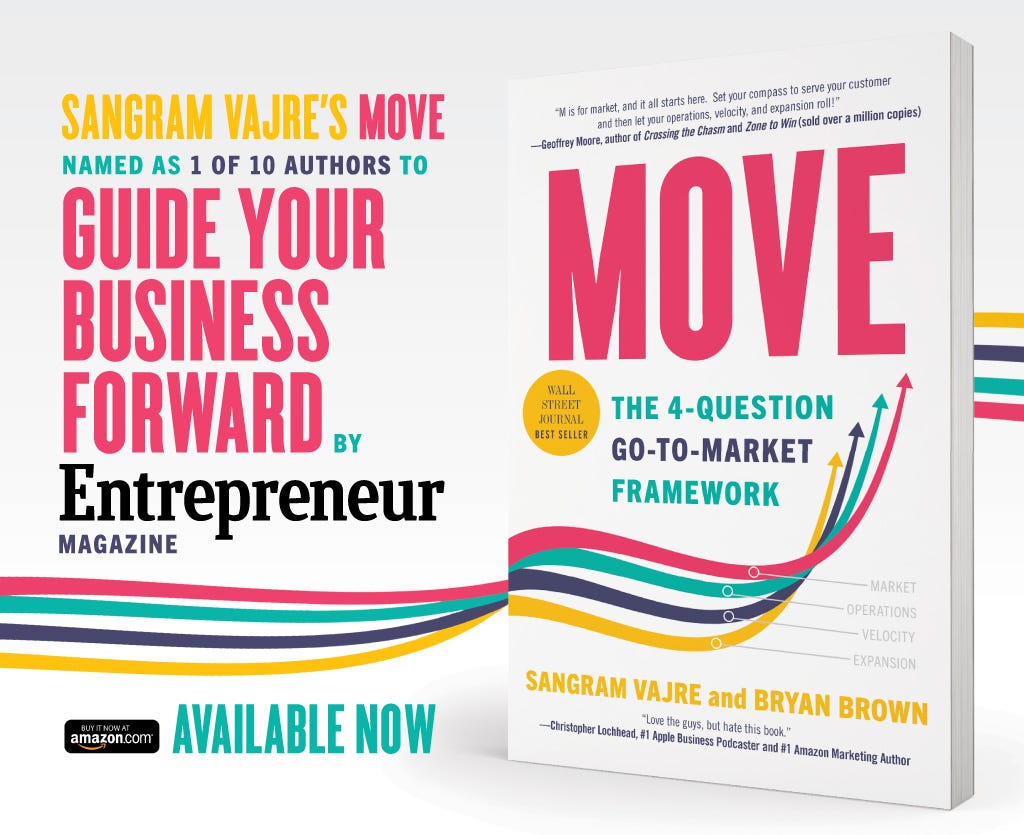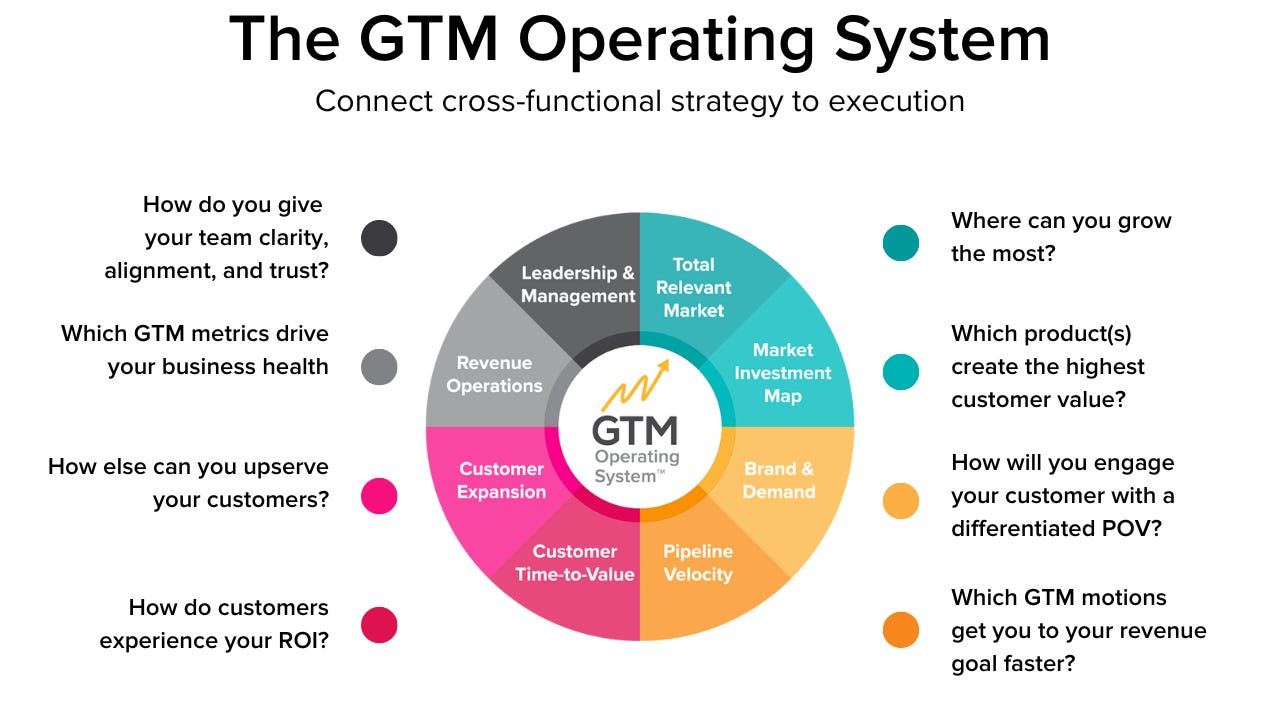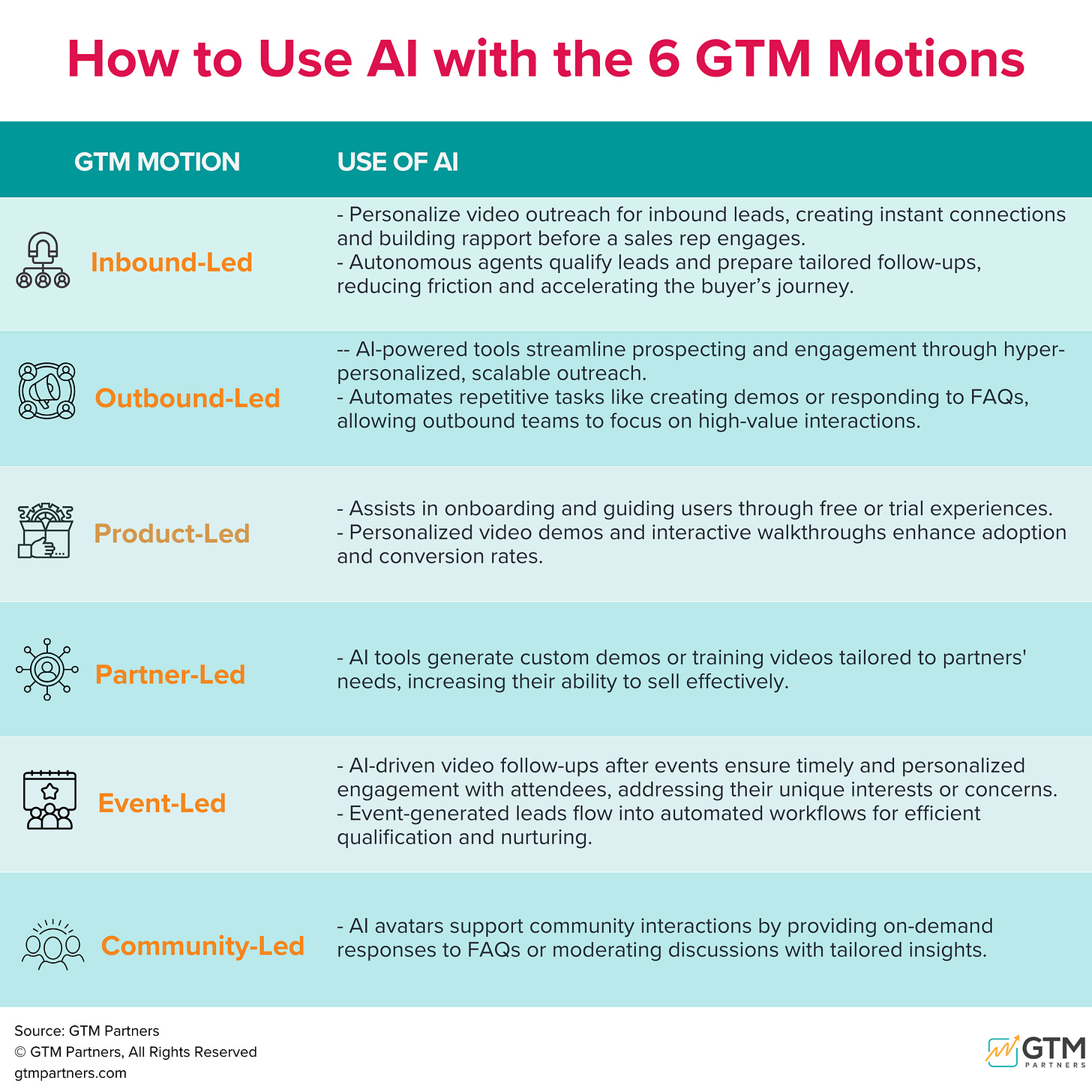Filters
A Look Back (and Forward) at the Framework That Helped Thousands of Revenue Teams Get Unstuck
Thanks for being one of over 175,000 forward-thinking GTM Leaders who subscribe to this weekly research note.
This week’s research note includes:
GTM Research: The Framework That Helped Thousands of Revenue Teams Get Unstuck
Spotlight: GTM Certified Partner John Ryan with GTM Value
Upcoming Events
Research: The Framework That Helped Thousands of Revenue Teams Get Unstuck
When we wrote MOVE: The 4-Question Go-to-Market Framework, we were responding to a clear and painful truth:
Most companies don’t have a clear way to connect strategy to execution.
We weren’t trying to write the final word on go-to-market. We were trying to offer the right questions—questions that could help leaders think clearly and act with purpose.
That was three years ago.
Since then, go-to-market has changed dramatically.
AI has reshaped how we execute.
Buying groups have grown larger and more complex.
Revenue leaders are under pressure to do more with less, and what used to work no longer moves the needle.
And yet…
We still hear from GTM leaders every week who tell us the questions in MOVE helped them get unstuck. That the framework gave them language for what they were experiencing. That it helped them lead better across functions, and not just react, but plan.
So while our GTM operating systems have matured—and our playbooks have expanded—the core of MOVE is still foundational. The four questions still unlock progress. The GTM maturity curve still offers a roadmap. And the six GTM truths we laid out still resonate.
This post is a refresher on the MOVE framework—not because it’s the only thing you need, but because it’s the best place to start if you want to understand what’s next.
What’s Changed and What Hasn’t?
We regularly get calls from CEO’s who had a board member who just recommended it or from a CMO who’s CEO asked the whole GTM team to read it.
Thousands of people (no exaggeration) are still taking the MOVE assessment linked to in the book.
But even with the advent of AI (which was hardly in widespread usage when we wrote the book) and all the changes in GTM that have occurred since, there is still a lot that holds true:
GTM is still hard: Companies still struggle to bridge the gap between their vision and effective execution
Our definition of GTM remains the same: GTM is a transformational process for accelerating your path to market with high-performing revenue teams delivering a connected customer experience. GTM acts as the vehicle that bridges your company's strategic objectives (purpose and dreams) with customer outcomes (realized benefits).
MOVE: the 4 Questions
If you want better answers, ask better questions.
These are the 4 questions that can and should define your exploration of your GTM journey:
Who should you MARKET to?
What do you need to OPERATE effectively?
When can you scale your business (VELOCITY)?
Where can you grow the most (EXPANSION)?
Any company that wants to create high-performing GTM revenue teams will benefit from the MOVE framework, because it gives you new ways to get unstuck and keep growing.
MOVE is just the beginning. Our work over the last two years has been about expanding on MOVE and building repeatable, predictable frameworks to address these challenges.
The 6 Core Principles of GTM that still hold true
3 years later, we still agree with these 6 “truths”:
GTM is like building a new product: You can’t approach GTM as if it were your company strategy, vision, or mission. It’s not a trite saying you post on the wall to collect dust. Rather, GTM is an iterative process that ensures what you’re selling is what you’re delivering, and you have to approach it in that way in order to make sure it is always working for you. Just like a product evolves over time with customer data and feedback, GTM should be treated similarly. Treating GTM as a product encourages ongoing investment and improvement.
GTM teams must go beyond marketing and sales to include customer success (and product!): GTM isn’t just a marketing thing; it’s a high-performing revenue thing. GTM revolves around high-performing revenue teams that unite marketing, sales, customer success, and product. Successful GTM implementation requires alignment among these four teams.
Focus on the relevance of your target market, not its size: Instead of targeting the largest possible market (total addressable market), concentrate on customers most relevant to your product (total relevant market).
RevOps drives growth: Accurate and standardized data from a single source is essential for informed decision-making. RevOps (Revenue Operations) acts as the "truth teller" responsible for managing and organizing data. Questions about a business can’t be answered by isolated, siloed departments.
Retention trumps acquisition: Acquiring new customers is more costly than retaining existing ones (5x more expensive on average). GTM should prioritize increasing customer lifetime value and enhancing the value of existing customers.
Embrace flywheels over funnels: Traditional lead funnels have a low conversion rate. Emphasize quality over quantity to avoid a wasteful churn process. Shift your focus from simply driving lead volume to efficient and effective revenue growth, where the goal is to progress opportunities with accounts that are a good fit. It’s quality over quantity, and every stage of the account life cycle has roughly equal weight.
The GTM Maturity Curve and the 3 P’s
To grasp where your GTM process stands, it's essential to understand the GTM maturity curve's three stages and three “P's”:
Ideation (Problem-Market Fit): In this stage, you lack a fully developed product and are uncertain about its market fit.
Transition (Product-Market Fit): With the right product-market fit, you shift focus to developing a repeatable, scalable process to increase market share.
Execution (Platform-Market Fit): As your company evolves into a multiproduct organization, the emphasis shifts from individual products to a platform approach.
Your company's stage in this curve depends on various factors beyond revenue, such as industry dynamics, market, category, and offerings.
From Ideation to Transition
In the ideation stage, focusing on leads is natural, as your ICP remains undefined.
However, transitioning to the next stage requires a shift in metrics, from funnel conversions to pipeline coverage, customer acquisition costs (CAC), and gross revenue retention. It's also crucial to align sales and marketing teams during this transition.
This transformation takes time, demanding research, patience, diligence, and goal alignment.
If transitioning from ideation to transition is challenging, evaluate key factors, including identifying your ideal customer, reliance on discounts, brand positioning, churn rates, customer understanding of ROI, product delivery, and sales team repeatability.
From Transition to Execution
If your product solves a problem and your GTM strategy focuses on quality acquisition with segmentation, you may be ready to move to the execution stage.
Here, you address multiple issues with additional product offerings on a repeatable and scalable platform. However, it may involve decentralization as you expand.
To transition successfully, assess factors such as product focus, distribution investment, metric predictability, product interdependence, product performance, market dominance, and team readiness.
Reviews for MOVE
We’re really honored to have so many five-star reviews on Amazon and direct quotes from some of best GTM leaders in thlike these:
“M is for Market, and it all starts here. Set your compass to serve your customer, and then let your operations, velocity, and expansion roll!”
—GEOFFREY MOORE, author of Crossing the Chasm (sold over 1M copies)“Go-to-market is like a product, and this book nails it with the MOVE framework.”
—BRIAN HALLIGAN, ex-CEO of HubSpot (public company with over one hundred thousand customers)“It hooked me immediately. The MOVE framework will make every revenue leader smarter and better.”
—MEAGEN EISENBERG, CMO of Samsara (advisor to twenty-five high-growth companies)“Your next MOVE is in this book, and it answers the questions every high-performing revenue team must answer.”
—KELLY FORD BUCKLEY, General Partner at Edison Partners (200+ successful exits)“MOVE is the blueprint for modern go-to-market companies, with customers at the center of it.”
—NICK MEHTA, CEO of Gainsight ($100 million+ in annual recurring revenue)“MOVE is the framework for turbo-scaling your business.”
—SCOTT DORSEY, Managing Partner at High Alpha (and former CEO of ExactTarget, acquired by Salesforce for $2.5 billion)“The ultimate go-to-market bible for every stage of your business.”
—DAVID CUMMINGS, CEO and Founder of Atlanta Ventures (fourth largest tech hub in the USA)“MOVE is the operating manual for all go-to-market leaders.”
—MARK ROBERGE, Co-Founder at Stage 2 Capital and Professor at Harvard Business School (and senior lecturer at Harvard Business School)
We’d love to hear from you if you’ve read the book recently. How did you hear about it? What did you think?
Take the MOVE Companion Course: Our Gift To You
As we’ve built GTM Partners, we’ve been deep in the trenches, helping thousands of B2B companies rethink and refine their go-to-market strategies.
Along the way, we kept hearing the same request:
Can you make this accessible to more people?
So, we finally did.
It’s becoming a MOVEment and you are invited to join.
Over a 1000 people have taking this course and NOW we’re giving you 14 days of access to the MOVE book Companion—a self-guided resource designed to help you and your team apply the GTM framework from MOVE.
It’s our gift to you with code gtmonday100.
The MOVE Companion Course is normally $499.
We’re offering it as a gift to readers of GTMonday for the next 14 days with the code gtmonday100.
If you spend 60 minutes with this course, you’ll get access to the following resources that tens of thousands of B2B companies have used:
✅ Self-paced learning videos including a clear breakdown of the 3 Ps of GTM (Problem-Market Fit, Product-Market Fit, Platform-Market Fit) that goes much deeper than the description in this research note
✅ A GTM assessment to evaluate where your business stands
✅ Ready-to-use templates and resources we’ve used with companies around the world
✅ A GTM Scorecard that will help you measure success and collaborate across silos
✅ A Netflix-style documentary featuring industry leaders like Geoffrey Moore, Jill Rowley, Christopher Lochhead, Kelly Ford Buckley, Scott Dorsey, Megan Eisenberg, Jay Baer, Bill Nussey, Sydney Sloane, Kyle Lacy, Scott Voigt, Nick Mehta, and Muhammad Yasin
Spotlight: GTM Certified Partner GTM Value
With over three decades in software and professional services, John Ryan at GTM Value has led, learned, and adapted through every major shift in the high-tech landscape. His journey has taken him from sales leadership to marketing turnarounds, from boardrooms of enterprise software billion-dollar exits to hands-on consulting for ambitious B2B companies.
What sets John apart isn’t just experience—it’s a relentless drive to stay current, challenge assumptions, and help others succeed. John believes the best GTM strategies blend proven fundamentals with fresh thinking, and he thrives on building bridges between generations, teams, and ideas.
GTM Advisor: Leverages the GTM Partners OS to create a powerful GTM Growth Culture in your company for sustainable growth.
Account-Based Everything: Works with your team to execute an account-centric strategy that keeps your GTM investment focused on the right accounts at the right time.
Partnerships and Ecosystem: With a long history of partner successes and recent awards, we will help you build a realistic strategy to improve your partnerships, drive down acquisition costs, speed up sales, and increase deal sizes.
If you’d like to be a certified GTM Partner like John Ryan at GTM Value and many others, we’d love to talk to you about how to make that happen.
Events: Where We’ll Be Speaking in 2025
(DM Sangram for a discount code to attend or to get slides after the talk)
Catch us at our upcoming keynotes and webinars:
The DemandXChange (hosted by TrustRadius): No Fluff, No Complexity: Build Your GTM Strategy in 8 Steps on One Slide Keynote, Live on June 5th at 12 pm ET
How Data Powers GTM Success: Systems, Signals, and Strategy (hosted by Sprout.ai), June 18 on LinkedIn Live
INBOUND (hosted by Hubspot), September 3-5 in San Francisco
DRIVE 2025 (hosted by Exit Five). September 10-11, Burlington, VT
Love,
Bryan and Sangram







